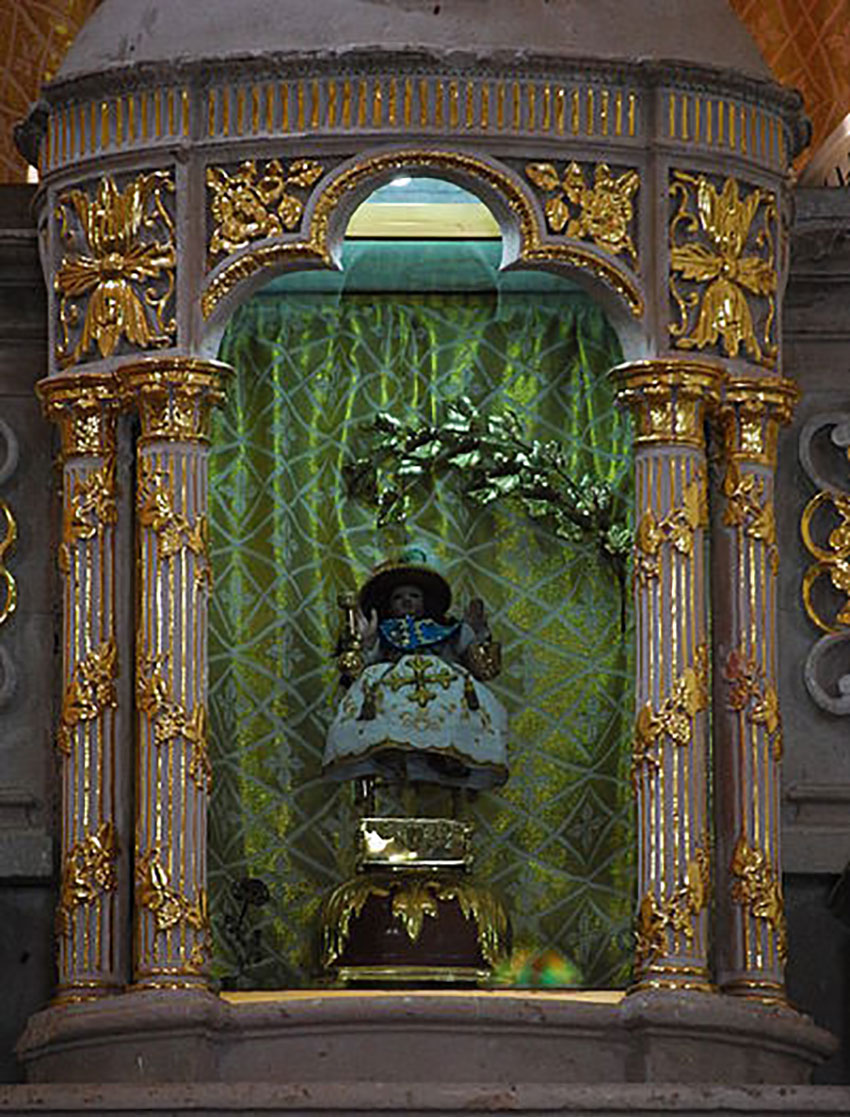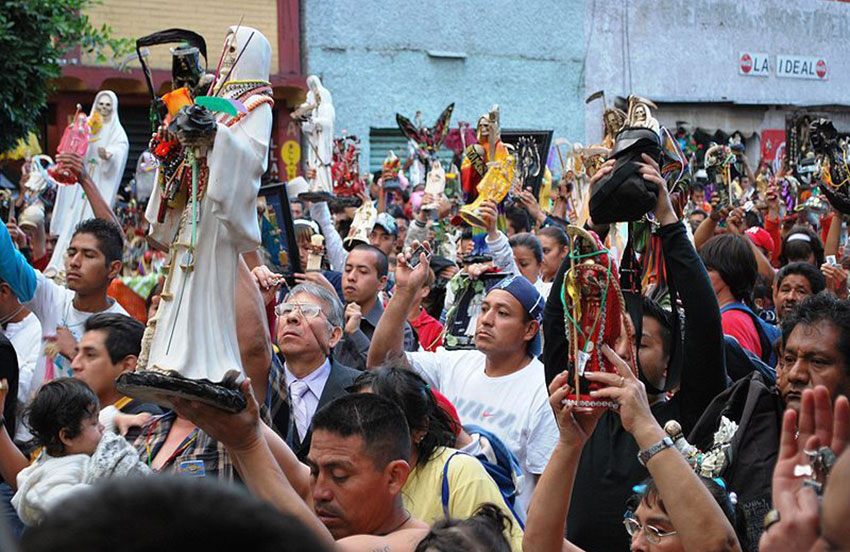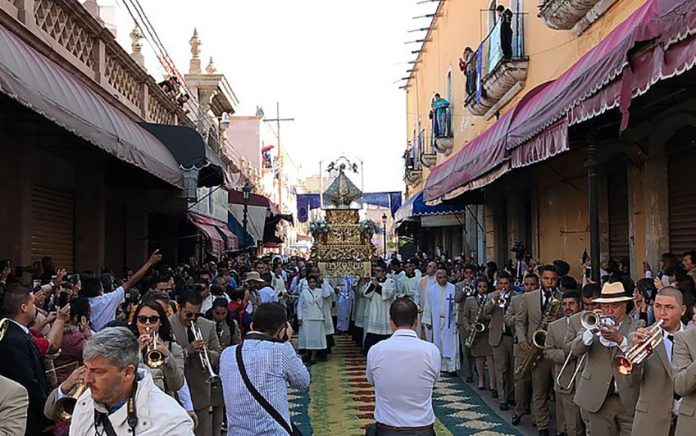You have probably seen it on a Mexican road, a long line of people in cars, on bikes and on foot. It is like a procession, but the people obviously have been traveling for some time.
Mexico has the second largest Catholic population in the world and these pilgrimages and their destinations reflect the country’s history and culture from the pre-Hispanic period to the present.
The Spanish imposed Catholicism on their newly conquered lands, but pilgrimage was part of indigenous life for many centuries prior. Taking advantage of similarities, Christian structures and images replaced the old ones, and in many cases, kept the same purpose. The Virgin Mary replaced various goddesses, and Jesus in various manifestations replaced male gods. In rare cases, the original image was replaced by a saint or archangel.
Therefore it is no surprise to find that the highest concentrations of shrines, as well as the largest, are found in the territories of former Mesoamerican empires.
The process of replacement was accompanied by some kind of miracle story. They include the appearance of the Virgin Mary, a Catholic image replacing pre-Hispanic one by supernatural means or an otherwise ordinary image which gains a reputation for granting many miracles. Not surprisingly, the miracles date to shortly after the arrival of the Spanish, with the involvement of Spanish authorities.

Not only are the Catholic sanctuaries in the same place as the old ones, pilgrims still use the same pilgrimage routes to get to them. Pilgrimages also include dances from the pre-Hispanic and early colonial period as a kind of meditation and prayer. This is likely because the evangelizers did not or could not eliminate the practice.
By far the most important pilgrimage site in Mexico is that of the Virgin of Guadalupe, located on Tepeyac Hill on the northern edge of Mexico City. It receives an estimated 20 million visitors each year from all over Mexico and elsewhere. The miracle associated with this site is the appearance of the Virgin Mary herself in 1531, which was sacred to Tonantzin, the mother goddess.
Proof of her appearance comes from her image on a maguey fiber cloth that was worn by Juan Diego Cuauhtlatoatzin and today hangs inside the newer Basilica built to handle the massive crowds. For Catholicism as a whole, it is a major Maronite site, just after Lourdes in France and Fatima in Portugal. The appearance of the Virgin as a dark-skinned indigenous was an extremely important factor in evangelization.
Guadalupe attracts large numbers of pilgrims and tourists year-round, but on her feast day of December 12, the city swells with thousands upon thousands, with groups of people completing their trek the night before along a road aptly named “Calzada de los Misterios” (Walkway of the Mysteries).
Despite the status of Guadalupe as religious and cultural icon, most of Mexico’s Catholic sanctuaries are dedicated to Jesus, either as infant, adult or on the cross. One subtype are crucifixes called Black Christs. These are images of Jesus on the cross where the human figure is darkened or completely black. Such crucifixes can be found from Central America into the southwest U.S. but the best known of these is in Chalma, a small town just west of Mexico City.
This image appeared in 1573, miraculously replacing the image of the god Ozoteotl, the god of caves, at his sanctuary. The image was brought to a church built in the 16th century, where it remains to this day. The site attracts thousands of pilgrims each year, especially July 1, January 6 and Ash Wednesday. Indigenous elements of pilgrimage remain important, such as dancing at the church and visiting a Montezuma cypress tree nearby.

The most important sanctuary dedicated to the infant Jesus is that of the Holy Child of Atocha in Plateros, Zacatecas, which has been registered as a World Heritage Site. The image here is a replica brought from Spain during the initial silver boom in the colonial period. During a major mining accident, according to the story, the image disappeared. Rescued miners told stories of how they saw a child come to them with food and water. After the emergency, the image reappeared. It is most strongly venerated in western Mexico up into the southwest U.S.
Another important category of sanctuary are those dedicated to specific images of the Virgin Mary, a physical object, not a supernatural appearance. There are many of these including the Virgin of Juquila in Oaxaca and the Virgin of Izamal in Yucatán, but the most visited is the one at San Juan de los Lagos, Jalisco.
The image was brought here in 1543 by Miguel de Bolonia. Her popularity rests on the many miracles attributed to this image, bringing about 5 million visitors each year from all over Mexico and Texas to the church that houses the image. Visitors come year-round but special dates are February 2, August 15, and December 8.
Sanctuaries dedicated to saints are rare in Mexico, but there is an important one dedicated to Judas Thaddeus or Jude the Apostle. Veneration of this image has taken on importance since the mid-20th century, mostly in Mexico City. The main sanctuary is the San Hipolito Church on the edge of the city’s historic center.
He is mostly venerated by the city’s poor, and interestingly, its criminal element, as misprints of his image had his staff in his left hand which represents evil, leading to the belief that he is the saint of good and bad alike. His feast day is October 2, when roads around the Hipolito become impassible, but large-scale veneration takes place each month on the 28th as well.
Another site of recent importance is Cubilete Hill just outside Silao, Guanajuato. This is home to a 20-meter bronze Christ located on the state’s highest point. The statue was completed in 1940, almost 20 years after the Mexican government stopped the attempt and banished the priest in charge of the project. At the time, the secular government was persecuting traditional Catholicism, an episode now known as the Cristero War.

It is still a sore point for many in north-central Mexico, which remains one of the country’s most conservative areas. To underscore this, there is a museum dedicated to the conflict at the statue’s base.
There is one type of sanctuary and pilgrimage site that is absolutely NOT sanctioned by the Catholic Church. These are dedicated to an image called Santa Muerte (Holy Death). The figure is similar to the Grim Reaper, with scythe and globe, but the image is considered female, not male. Its veneration is most strongly associated with the poor and criminals, those who believe that there is no place in traditional religion for them.
The most important shrine for this image is in front of a small house in the very seedy Tepito neighborhood in Mexico City, established only a few decades ago. It attracts devotees daily with major gatherings on the first of each month and despite its non-sanctioned status, is venerated with Catholic rites such as crossing oneself and saying the rosary.
There are too many sites with spiritual significance even for a book, and a few have managed to keep 100% their indigenous character. Such sanctuaries have both religious and cultural significance, and attract visitors for both reasons. For the faithful, the trip is for penance, to ask a favor or to give thanks and can be profound.
For the visitor, it provides a look into a culture and way of life, often on a microcosmic scale. Visits to such places generally have rules and norms, and obviously should be respected even by non-believers.
Leigh Thelmadatter arrived in Mexico 17 years ago and fell in love with the land and the culture. She publishes a blog called Creative Hands of Mexicoand her first book, Mexican Cartonería: Paper, Paste and Fiesta, was published last year. Her culture blog appears weekly on Mexico News Daily.
